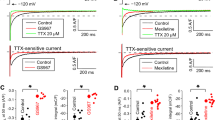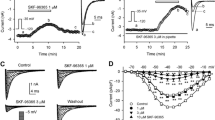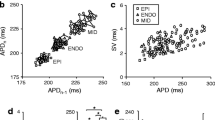Abstract
In spite of its widespread clinical application, there is little information on the cellular cardiac effects of the dopamine receptor agonist ropinirole. In the present study, therefore, the concentration-dependent effects of ropinirole on action potential morphology and the underlying ion currents were studied in enzymatically dispersed canine ventricular cardiomyocytes using standard microelectrode, conventional whole-cell patch clamp, and action potential voltage clamp techniques. At concentrations ≥ 1 μM, ropinirole increased action potential duration (APD90) and suppressed the rapid delayed rectifier K+ current (I Kr) with an IC50 value of 2.7 ± 0.25 μM and Hill coefficient of 0.92 ± 0.09. The block increased with increasing depolarizations to more positive voltages, but paradoxically, the activation of I Kr was accelerated by 3 μM ropinirole (time constant decreased from 34 ± 4 to 14 ± 1 ms). No significant changes in the fast and slow deactivation time constants were observed with ropinirole. At higher concentrations, ropinirole decreased the amplitude of early repolarization (at concentrations ≥ 10 μM), reduced the maximum rate of depolarization and caused depression of the plateau (at concentrations ≥ 30 μM), and shortened APD measured at 50% repolarization (at 300 μM) indicating a concentration-dependent inhibition of I to, I Na, and I Ca. Suppression of I Kr, I to, and I Ca has been confirmed under conventional patch clamp and action potential voltage clamp conditions. I Ks and I K1 were not influenced significantly by ropinirole at concentrations less than 300 μM. All these effects of ropinirole were fully reversible upon washout. The results indicate that ropinirole treatment may carry proarrhythmic risk for patients with inherited or acquired long QT syndrome due to inhibition of I Kr—especially in cases of accidental overdose or intoxication.





Similar content being viewed by others
References
Bányász T, Fülöp L, Magyar J, Szentandrássy N, Varró A, Nánási PP (2003) Endocardial versus epicardial differences in L-type calcium current in canine ventricular myocytes studied by action potential voltage clamp. Cardiovasc Res 58:66–75
Bányász T, Magyar J, Szentandrássy N, Horváth B, Birinyi P, Szentmiklósi J, Nánási PP (2007) Action potential clamp fingerprints of K+ currents in canine cardiomyocytes: their role in ventricular repolarization. Acta Physiol 190:189–198
Dewy RB, Reimold SC, O’Suilleabhain PE (2007) Cardiac valve regurgitation with pergolide compared with nonergot agonists in Parkinson’s disease. Arch Neurol 64:377–380
Fischmeister R, DeFelice LJ, Ayer RK, Levi R, DeHaan RL (1984) Channel currents during spontaneous action potentials in embryonic chick heart sells. The action potential patch clamp. Biophys J 46:267–271
Hamill OP, Marty A, Neher E, Sakmann B, Sigworth FJ (1981) Improved patch-clamp techniques for high-resolution current recording from cells and cell-free membrane patches. Pflügers Arch 391:85–100
Hondeghem LM, Katzung BG (1977) Time- and voltage-dependent interactions of antiarrhythmic drugs with cardiac sodium channels. Biochim Biophys Acta 472:373–398
Horváth B, Magyar J, Szentandrássy N, Birinyi P, Nánási PP, Bányász T (2006) Contribution of I Ks to ventricular repolarization in canine myocytes. Pflügers Arch 452:698–706
Humphrey SJ, Turman CN, Curry JT, Wheeler GJ (2006) Cardiovascular and electrocardiographic effects of the dopamine receptor agonists ropinirole, apomorphine, and PNU-142774E in conscious beagle dogs. J Cardiovasc Pharmacol 47:337–347
Hurst RS, Higdon NR, Lawson JA, Clark MA, Rutherford-Root KL, McDonald WG, Haas JV, McGrath JP, Meglasson MD (2003) Dopamine receptor agonists differ in their actions on cardiac ion channels. Eur J Pharmacol 482:31–37
Kaye CM, Nicholls B (2000) Clinical pharmacokinetics of ropinirole. Clin Pharmacokinet 39:243–254
Rothman RB, Baumann MH (2009) Serotonergic drugs and valvular heart disease. Expert Opin Drug Safety 8:317–329
Rothman RB, Baumann MH, Savage JE, Rauser L, McBride A, Hufeisen SJ, Roth BL (2000) Evidence for possible involvement of 5-HT2B receptors in the cardiac valvulopathy associated with fenfluramine and other serotonergic medications. Circulation 102:2836–2841
Schrag AE, Brooks DJ, Brunt E, Fuell D, Korczyn A, Poewe W, Quinn NP, Rascol O, Stocchi F (1998) The safety of ropinirole, a selective nonergoline dopamine agonist, in patients with Parkinson’s disease. Clin Neuropharmacol 21:169–175
Strichartz G, Cohen I (1978) V max as a measure of G Na in nerve and cardiac membranes. Biophys J 23:153–156
Swagzdis JE, Wittendorf RW, DeMarinis RM, Mico BA (1986) Pharmacokinetics of dopamine-2 agonists in rats and dogs. J Pharm Sci 75:925–928
Szabó G, Szentandrássy N, Bíró T, Tóth IB, Czifra G, Magyar J, Bányász T, Varró A, Kovács L, Nánási PP (2005) Asymmetrical distribution of ion channels in canine and human left ventricular wall: epicardium versus midmyocardium. Pflügers Arch 450:307–316
Szentandrássy N, Bányász T, Bíró T, Szabó G, Tóth IB, Magyar J, Lázár J, Varró A, Kovács L, Nánási PP (2005) Apico-basal inhomogeneity in distribution of ion channels in canine and human ventricular myocardium. Cardiovasc Res 65:851–860
Szymanski C, Boey S, Hermida JS (2008) Ropinirole-induced symptomatic sinus node dysfunction. PACE 31:1078–1081
Thompson DJ, Vearer D (2007) Steady-state pharmacokinetic properties of a 24-hour prolonged-release formulation of ropinirole: results of two randomized studies in patients with Parkinson’s disease. Clin Ther 29:2654–2666
Yang T, Snyders D, Roden DM (2001) Drug block of IKr: model systems and relevance to human arrhythmias. J Cardiovasc Pharmacol 38:737–744
Acknowledgements
Financial support for the studies was provided by grants from the Hungarian Scientific Research Fund (OTKA-K68457, OTKA-K73160, CNK-77855). Further support was obtained from the Medical and Health Science Center of University of Debrecen (MEC-14/2008). The authors thank István Bak for his kind help.
Author information
Authors and Affiliations
Corresponding author
Rights and permissions
About this article
Cite this article
Simkó, J., Szentandrássy, N., Harmati, G. et al. Effects of ropinirole on action potential characteristics and the underlying ion currents in canine ventricular myocytes. Naunyn-Schmied Arch Pharmacol 382, 213–220 (2010). https://doi.org/10.1007/s00210-010-0538-1
Received:
Accepted:
Published:
Issue Date:
DOI: https://doi.org/10.1007/s00210-010-0538-1




